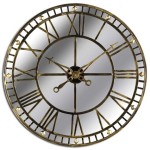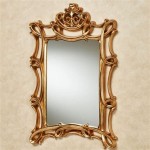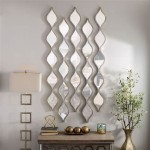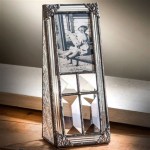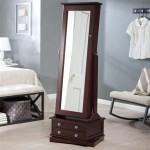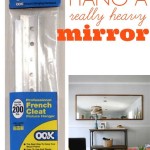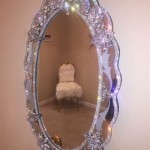Hanging Mirror Double Sided Tape: A Comprehensive Guide
Mirrors add dimension and light to any space, making them a popular decorative and functional element in homes and businesses. Securely mounting a mirror, especially a heavy one, requires a reliable and robust method. While traditional methods like screws and wires are still prevalent, double-sided tape designed specifically for hanging mirrors offers a convenient and often damage-free alternative.
Double-sided mirror tape provides a strong adhesive bond between the mirror and the wall, eliminating the need for drilling holes. This adhesive solution offers several benefits, including ease of installation, a clean finish, and suitability for various wall surfaces. However, choosing the right tape and understanding proper application techniques is critical for ensuring a secure and long-lasting hold.
Various types of double-sided tape exist, each formulated with specific adhesive properties to suit different applications. For hanging mirrors, selecting a tape specifically designed for this purpose is paramount. These specialized tapes are engineered to hold significant weight and adhere firmly to both the mirror's backing and the wall material. Look for tapes explicitly marketed for mirrors or heavy-duty mounting, as they will provide the necessary strength and durability.
The load-bearing capacity of the tape is a critical consideration. Manufacturers generally specify the maximum weight a particular tape can support. It is crucial to choose a tape with a weight capacity that exceeds the weight of the mirror being hung. This provides a safety margin and ensures a secure hold. Weighing the mirror accurately before selecting the tape is essential to avoid potential accidents and damage.
Different wall surfaces require different adhesive approaches. Smooth surfaces like tile, glass, and metal generally provide a good bonding surface for double-sided tape. However, porous surfaces like brick, concrete, or textured wallpaper may require specific types of tape or additional surface preparation for optimal adhesion. Always check the manufacturer’s recommendations for compatibility with the intended wall surface.
Proper surface preparation is crucial for achieving a strong and lasting bond. Both the back of the mirror and the wall surface should be clean, dry, and free of dust, grease, or other contaminants. Cleaning with isopropyl alcohol is often recommended to ensure optimal adhesion. For porous surfaces, a primer may be necessary to create a smooth and even surface for the tape to adhere to.
Applying the double-sided tape correctly is essential for a secure hold. The tape should be applied to the back of the mirror in vertical strips, evenly spaced and extending to within an inch of the mirror's edges. Avoid applying the tape in a continuous perimeter strip, as this can trap air and weaken the bond. Follow the manufacturer’s instructions for specific application guidelines.
Once the tape is applied to the mirror, carefully position the mirror on the wall, ensuring it is level and in the desired location. Press firmly and evenly across the entire surface of the mirror to activate the adhesive and create a strong bond. Some tapes require a curing period, during which the adhesive reaches its full strength. Consult the manufacturer's instructions for the recommended curing time.
Temperature and humidity can affect the performance of double-sided tape. Extreme temperatures, both hot and cold, can weaken the adhesive bond. High humidity can also compromise adhesion. It is best to apply the tape in a temperature-controlled environment and avoid hanging mirrors in areas exposed to extreme temperature fluctuations or excessive moisture.
While double-sided tape offers a convenient and effective method for hanging mirrors, certain limitations exist. Very large or exceptionally heavy mirrors may require alternative mounting methods for optimal safety and security. Additionally, removing the mirror once it has been attached with double-sided tape can be challenging and may damage the wall surface. Careful consideration of these factors is crucial before opting for this method.
Removing a mirror mounted with double-sided tape requires careful attention to avoid damaging the wall. A thin, sharp tool like a putty knife or a guitar pick can be used to gently pry the mirror away from the wall. Applying heat with a hairdryer can soften the adhesive, making removal easier. Residual adhesive can be removed with a specialized adhesive remover, following the manufacturer’s instructions.
Safety should always be a primary concern when hanging mirrors, especially heavy ones. Ensuring the chosen tape is appropriate for the weight of the mirror and the wall surface is crucial. Following the manufacturer's instructions carefully and taking necessary precautions, such as wearing gloves and eye protection, will help ensure a safe and successful installation.
Choosing the right double-sided tape for hanging a mirror involves considering factors such as weight capacity, wall surface compatibility, and environmental conditions. Careful surface preparation and proper application techniques are essential for achieving a strong and lasting bond. By understanding these key aspects, individuals can confidently utilize double-sided tape as a reliable and convenient method for securely mounting mirrors.

Scotch Fix Mirror Mounting Tape 4496w 1950 P 19mm X 5m 1 Roll Pack 3m United Kingdom

Adhesive Double Sided Mirror Tape Tesa

Tesa Powerbond Mirror 5m X 19mm Adhesive Solutions

Scotch Fix Mirror Mounting Tape 4496w 1950 P 19mm X 5m 1 Roll Pack 3m United Kingdom

Multi Purpose Double Sided Mounting Hanging Mirror Foam Fixing Tape 18mm Tt1003

Ultratape Double Sided Tape Sticky Foam Mirror Hanging Car Number Plate 50mmx10m

Scotch Fix Mirror Mounting Tape 4496w 1950 P 19mm X 5m 1 Roll Pack 3m United Kingdom

Gorilla 1 In X 67 Yd Black Heavy Duty Mounting Tape 6055002 The Home Depot

Scotch 1 X 50 Roll Pack Indoor Double Sided Mounting Tape Target

Scotch 1 In X 60 Yds Permanent Double Sided Clear Mounting Tape 410dc Sf The Home Depot

